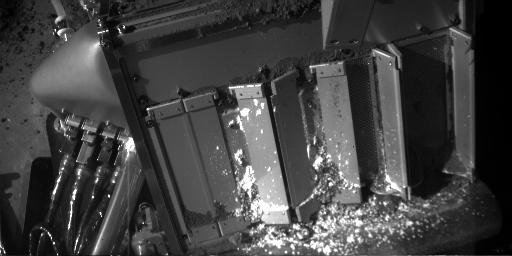Emily Lakdawalla • Sep 29, 2008
Phoenix Update, Sol 123: Press briefing with carbonates, clays, and snow!
EDIT: I just got a couple of the graphs that they showed during today's briefing, which didn't make it on to the JPL or Arizona websites for some reason. They're included below.
There was a long-awaited press briefing from the Phoenix team this week. They had a lot of ground to cover, with no fewer than six presenters in two different locations, each giving a short summary of something newsy, so a list works best to summarize what they had to say:
- Using their lidar instrument, the meteorological team has detected snow falling from elevations of about 4 kilometers down to 2.5 kilometers, and it probably fell lower before sublimating. They said they'll be watching to see if any snow eventually reaches the ground.
They had a neat graph of this data that hasn't made it to the mission websites yet.Watching snow fall on Mars! Cool.
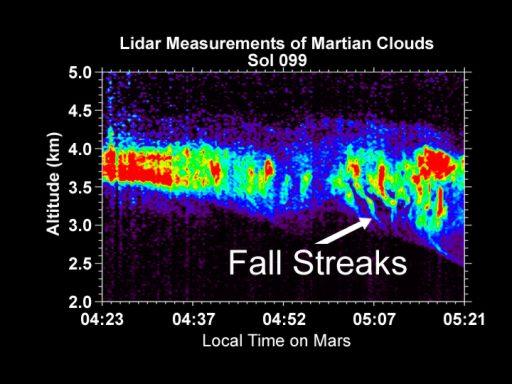
Phoenix lidar sees snow falling from Martian clouds
In the early morning hours of sol 99, Phoenix used its lidar (a skyward-pointing green laser beam) to search for clouds. The beam detected clouds at elevations between 3.5 and 4 kilometers above the surface. As the observation continued, it detected "fall streaks," where ice crystals that formed within the clouds began to descend toward the ground; as they descended, different wind speeds at different altitudes caused the sheets of falling snow crystals to shear out horizontally. When the lidar experiment quit operating at 05:21 local time, the crystals had fallen to an elevation of 2.5 kilometers, and probably fell further before they reached air that was dry enough to cause the crystals to sublimate back into a gas. Later in the season, the falling snow may survive all the way to the surface.- Both of the two main analytical instruments, TEGA and MECA, have confirmed the presence of calcium carbonate (a.k.a. calcite) in their samples, relatively abundant at a few percent of the total soil mass. This is important because calcite is usually associated with liquid water.
- The TEGA team thinks they have also detected clay minerals, which isn't much of a surprise. MECA is unable to confirm this yet. This is also no surprise; MECA is designed to detect things that dissolve in water; calcite can dissolve fairly readily under the right conditions, while clays do not.
- The MECA team reported a firmer estimate of the soil pH as 8.3, which they said was very similar to the pH of Earth's oceans. The pH of Earth's oceans is actually buffered in part by feedback cycles among carbonate rocks and carbon dioxide in the atmosphere. If things get more acid, the oceans dissolve calcium carbonate, which, in turn, raises the pH, so the system winds up being pretty stable at that pH.
- The TEGA team has not yet detected organics. Further analysis of the data they already have on the ground could still yield that discovery, and there are still four ovens they haven't filled yet. If it's there, it's "not very much." Still, they are going ahead and performing a TEGA test using the "Organic-free blank" they brought from Earth, which will help them establish TEGA's detection limit.
- Despite several further attempts, they also still haven't gotten an ice sample into TEGA yet. They seem to be giving up on Snow White for now. They may try again, at a different location. They have to hurry to get samples into the remaining four ovens while power levels are still happy.
- Currently, Phoenix is expected to survive through most of November.
- If, by some miracle, it survives the coming Martian winter (during which it will spend hundreds of sols encased in carbon dioxide ice), it is programmed with a "Lazarus mode" to phone home once its batteries are charged enough. Although sunlight will return to the Phoenix site by mid-April, if it does survive, and assuming its solar panels aren't snapped off, it won't be until October that its batteries could charge enough for it to use its radio to attempt contact with Earth.
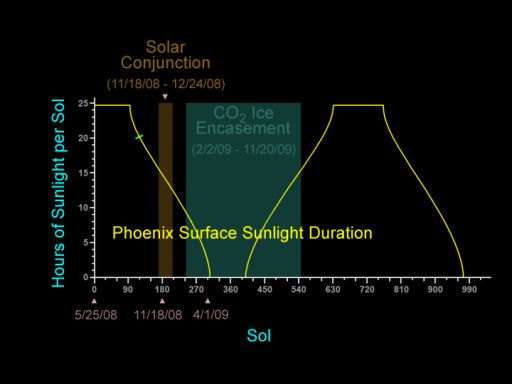
NASA / JPL
Phoenix' sunlight situation
The yellow curve on this graph shows the number of hours of sunlight at Phoenix' landing site in Mars' norhtern plains. For the first 100-plus sols, there was sunlight around the clock. Now that the autumn is approaching, though, the Sun dips below the horizon for longer and longer each day; the green tick mark shows the situation on sol 123 of the mission, September 28, 2008, with darkness about 4 hours per sol. Decreasing sunlight means lower temperatures and less power; Phoenix is not expected to continue functioning past November 2008, through Mars' solar conjunction (marked in brown). With the arrival of autumn, the temperature will get cold enough that Mars' carbon dioxide atmosphere will freeze to the ground, encasing Phoenix in dry ice; the temperatures are cold enough to cause "glassification" and cracking of its circuit boards, most likely damaging the spacecraft too much for it to wake up in the spring.- There was mention of an interest in turning on MARDI to see if it and its microphone still work, but evidently they haven't taken that step yet.
I've updated the Robotic Arm Camera images page and my sol-by-sol summary for the first time in several weeks (sorry about that hiatus). There have been some neat images lately. Here's my favorites -- a pair of vanity shots, two cameras on the lander taking photos of each other.
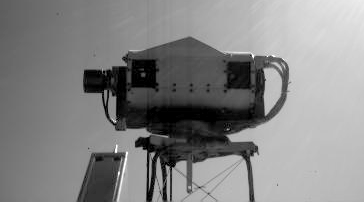
NASA / JPL / UA / MPI / animation by Emily Lakdawalla
Phoenix SSI
On sol 116, Phoenix' mast-mounted and arm-mounted cameras captured vanity portraits of each other. This animation includes two images from the robotic arm camera of the mast-mounted camera, one facing the viewer and one with the head turned away.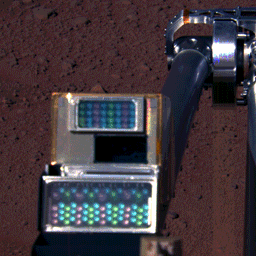
NASA / JPL / UA / Texas A & M / color animation by Doug Ellison
Phoenix robotic arm camera with flashing LEDs
On sol 116, Phoenix' mast-mounted and arm-mounted cameras captured vanity portraits of each other. This animation includes several photos of the robotic arm camera, which turned on sets of red, green, and blue LEDs as the mast-mounted camera watched.It looks like they are trying to deliver material scraped from the organic-free blank to oven 2. (The organic-free blank is a material brought from Earth that they will use to verify any possible organic detection; there is no organic material in the organic-free blank, so whatever signal they want to call "organics" measured from Mars soil had better have a stronger signature than what they see when they test the organic-free blank.) That organic-free blank stuff looks crazily white inside the robotic arm scoop, like freshly fallen snow; here's an image from sol 122 where you can see the dusty stuff inside the scoop. It seems to have another similarity to snow: it blows easily in the Martian wind. Check out this animation (and props to the guys on unmannedspaceflight.com who noticed the material flying away):
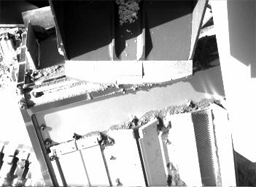
NASA / JPL / UA / MPI / animation by Emily Lakdawalla
Delivering a sample of 'organic-free blank' material to TEGA oven 2, sol 122
On sol 122 Phoenix scraped some material from its organic-free blank (to calibrate the TEGA instrument) and attempted delivery to the barely open doors of TEGA oven 2. As the scoop tilted to drop the fine, bright white material, the wind blew at least some of it away. The eight images in this animation were taken approximately 20 seconds apart, covering a span of about two minutes.Let’s Go Beyond The Horizon
Every success in space exploration is the result of the community of space enthusiasts, like you, who believe it is important. You can help usher in the next great era of space exploration with your gift today.
Donate Today

 Explore Worlds
Explore Worlds Find Life
Find Life Defend Earth
Defend Earth


